Chalfonts and Gerrards Cross Hospital
Hampton Road, Gerrards Cross, Bucks SL9 9DR
Medical
dates:
Medical
character:
Acute. Later, G.P. Currently, OPD only.
The Chalfonts and Gerrards Cross
Cottage Hospital was officially opened on 19th June 1871 by the Lord
Bishop of the Diocese. It had 6 beds and 1 cot.
The building and the land had been a gift of Mr and Mrs John Nembhard Hibbert of Chalfont Park. The Hospital was intended primarily to serve the poor of the parishes of Chalfont St Peter, Chalfont St Giles and Gerrards Cross.
During WW1 (1914-1918) 4 beds were reserved for wounded servicemen.
In 1923 the Hospital was extended, and again in 1927. In December 1927 it had to close for three months as the building work created too much dust and noise, making nursing impossible. It reopened on 13th April 1928.
In 1928 supporters of the Hospital had gathered a large amount of tinfoil (which the Hospital sold to raise funds), but the price of tin had fallen considerably and only £8 14s 5d (£8.72) was realised.
On 11th June 1928 work began on the extension of the whole of the kitchen wing, which would include a new staircase, new private wards, a new bathroom, an enlarged Staff Room (to be used temporarily as a ward) and a temporary Staff Room.
The extension was completed early in March 1929 and officially opened on 13th April 1929 by the Lord-Lieutenant of the County, Lord Cottesloe. The Hospital then had 18 beds.
During 1929 the daily cost of an in-patient was 13s 10d (69p) - £4.83 a week - compared to the previous year of 10s 7d (53p) - £3.71 a week. The average daily bed occupancy was 50% and the average length of stay 14 days.
On 1st April 1929, to offset the costs of hospital care, a Contributory Scheme was established for those whose incomes did not exceed £250 a year. A family with children up to 14 years of age would contribute 3d (1.25p) a week, while individuals over the age of 21 years, widows and widowers and their children up to 14 years would pay 2d (0.8p). The charge for 14-21 year-olds was 1d (0.4p). By 31st March 1930, some 1,668 had joined the Scheme.
In 1930 the daily cost of an in-patient was 11s 4d (57p) - £3.97 a week - although this figure also included the costs of re-equipping the wards; the real cost was just over 10s (50p).
The medical staff wanted to increase the number of beds to 30, and fund-raising began for a new wing.
In 1931 the daily cost of an in-patient was 10s 7d (53p).
In 1934 the Hospital was enlarged, after which it had 36 beds.
In 1939 the Hospital joined the Emergency Medical Service (E.M.S.). However, its blackout arrangements proved inadequate and extensive additional work had to be carried out to make the building light-proof. The sandbags providing protection against bomb blast had become rotten and were replaced by concrete blast walls.
In 1940 there were 885 admissions (140 more than in 1939). Of these, 43 were service or evacuee cases, for which the Ministry of Health gave a grant under the E.M.S. agreement.
The weekly cost of an in-patient was £3 14s 7d (£3.73) in 1940, compared with £3 15s 3d (£3.76) in 1939. The average length of stay remained 14 days.
In 1948 the Hospital joined the NHS under the control of the High Wycombe and District Hospital Management Committee, part of the Oxford Regional Hospital Board. It had 36 beds.
In 1974, following a major reorganisation of the NHS, it came under the auspices of the Buckinghamshire Area Health Authority, part of the Oxford Regional Health Authority. It became a G.P. unit with 32 beds.
In 1982, after another major reorganisation of the NHS, it came under the control of the Wycombe District Health Authority.
In 1993, with the introduction of the marketplace system into the NHS, the Hospital became part of the South Buckinghamshire NHS Trust. It had 31 beds.
In 2004 it was used as one of the pilot sites for early medical abortion, where drugs were trialled to replace surgery.
In 2006 the out-patient facilities were renovated.
In September 2008 the last remaining ward, with 14 beds, closed. It had been condemned as unsafe as it was on the first floor and fire officers decided there was inadequate emergency access to evacuate patients in the event of a fire. The remaining four patients were transferred to the Waterside Unit at Amersham Hospital.
It was unclear at this stage whether the closure would be permanent. The building was in poor condition and required about £4m of repairs, including rewiring, replumbing and the removal of asbestos.
The Buckinghamshire Primary Care Trust, now running the Hospital, considered whether to build a new hospital with 24 beds on a greenfield site, but this did not happen.
Update: March 2016
Following another major NHS reorganisation, Primary Care Trusts ceased to exist in April 2013. The Hospital is now managed by the Buckinghamshire Healthcare NHS Trust. It provides a range of specialist clinics, including general surgery, neurology, ophthalmology, orthopaedics, paediatrics, E.N.T., rheumatology, urology, vascular and gynaecology.
The building and the land had been a gift of Mr and Mrs John Nembhard Hibbert of Chalfont Park. The Hospital was intended primarily to serve the poor of the parishes of Chalfont St Peter, Chalfont St Giles and Gerrards Cross.
During WW1 (1914-1918) 4 beds were reserved for wounded servicemen.
In 1923 the Hospital was extended, and again in 1927. In December 1927 it had to close for three months as the building work created too much dust and noise, making nursing impossible. It reopened on 13th April 1928.
In 1928 supporters of the Hospital had gathered a large amount of tinfoil (which the Hospital sold to raise funds), but the price of tin had fallen considerably and only £8 14s 5d (£8.72) was realised.
On 11th June 1928 work began on the extension of the whole of the kitchen wing, which would include a new staircase, new private wards, a new bathroom, an enlarged Staff Room (to be used temporarily as a ward) and a temporary Staff Room.
The extension was completed early in March 1929 and officially opened on 13th April 1929 by the Lord-Lieutenant of the County, Lord Cottesloe. The Hospital then had 18 beds.
During 1929 the daily cost of an in-patient was 13s 10d (69p) - £4.83 a week - compared to the previous year of 10s 7d (53p) - £3.71 a week. The average daily bed occupancy was 50% and the average length of stay 14 days.
On 1st April 1929, to offset the costs of hospital care, a Contributory Scheme was established for those whose incomes did not exceed £250 a year. A family with children up to 14 years of age would contribute 3d (1.25p) a week, while individuals over the age of 21 years, widows and widowers and their children up to 14 years would pay 2d (0.8p). The charge for 14-21 year-olds was 1d (0.4p). By 31st March 1930, some 1,668 had joined the Scheme.
In 1930 the daily cost of an in-patient was 11s 4d (57p) - £3.97 a week - although this figure also included the costs of re-equipping the wards; the real cost was just over 10s (50p).
The medical staff wanted to increase the number of beds to 30, and fund-raising began for a new wing.
In 1931 the daily cost of an in-patient was 10s 7d (53p).
In 1934 the Hospital was enlarged, after which it had 36 beds.
In 1939 the Hospital joined the Emergency Medical Service (E.M.S.). However, its blackout arrangements proved inadequate and extensive additional work had to be carried out to make the building light-proof. The sandbags providing protection against bomb blast had become rotten and were replaced by concrete blast walls.
In 1940 there were 885 admissions (140 more than in 1939). Of these, 43 were service or evacuee cases, for which the Ministry of Health gave a grant under the E.M.S. agreement.
The weekly cost of an in-patient was £3 14s 7d (£3.73) in 1940, compared with £3 15s 3d (£3.76) in 1939. The average length of stay remained 14 days.
In 1948 the Hospital joined the NHS under the control of the High Wycombe and District Hospital Management Committee, part of the Oxford Regional Hospital Board. It had 36 beds.
In 1974, following a major reorganisation of the NHS, it came under the auspices of the Buckinghamshire Area Health Authority, part of the Oxford Regional Health Authority. It became a G.P. unit with 32 beds.
In 1982, after another major reorganisation of the NHS, it came under the control of the Wycombe District Health Authority.
In 1993, with the introduction of the marketplace system into the NHS, the Hospital became part of the South Buckinghamshire NHS Trust. It had 31 beds.
In 2004 it was used as one of the pilot sites for early medical abortion, where drugs were trialled to replace surgery.
In 2006 the out-patient facilities were renovated.
In September 2008 the last remaining ward, with 14 beds, closed. It had been condemned as unsafe as it was on the first floor and fire officers decided there was inadequate emergency access to evacuate patients in the event of a fire. The remaining four patients were transferred to the Waterside Unit at Amersham Hospital.
It was unclear at this stage whether the closure would be permanent. The building was in poor condition and required about £4m of repairs, including rewiring, replumbing and the removal of asbestos.
The Buckinghamshire Primary Care Trust, now running the Hospital, considered whether to build a new hospital with 24 beds on a greenfield site, but this did not happen.
Present status (August 2009)
The Hospital is still operational and continues to provide out-patient services only, including X-ray and physiotherapy.
Update: March 2016
Following another major NHS reorganisation, Primary Care Trusts ceased to exist in April 2013. The Hospital is now managed by the Buckinghamshire Healthcare NHS Trust. It provides a range of specialist clinics, including general surgery, neurology, ophthalmology, orthopaedics, paediatrics, E.N.T., rheumatology, urology, vascular and gynaecology.
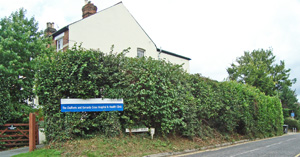
Signage at the foot of Hampton Road.
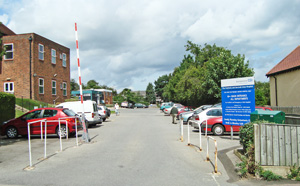
The main driveway into the Hospital campus.
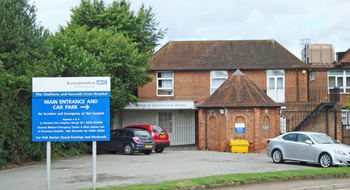
Perhaps the original entrance to the Hospital on the south side of the site. It is unclear what the small round building in front would have been designed for.
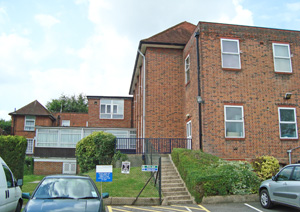
The buildings from the east. The Hospital has been much extended.
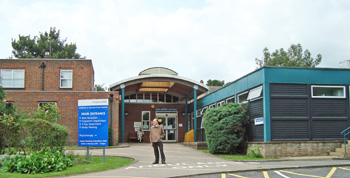
The main entrance to the Hospital from the car park.
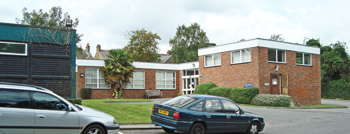
The northern block contains the Physiotherapy Department.
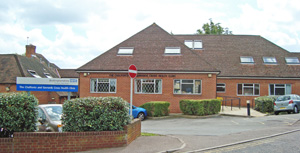
The Chalfonts and Gerrards Cross Health Clinic.
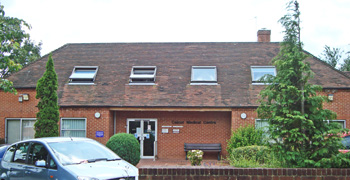
The Calcot Medical Centre is adjacent to the Hospital on Hampden Road.
Wheelband A 1989 Chalfont St Peter in old picture postcards, Vol. 2. Zaltbommel, European Library.
http://archiseek.com
www.british-history.ac.uk
www.buckscc.gov.uk
www.chalfontstpeter.com
www.chiltern.gov.uk
www.eprints.soton.ac.uk
www.getbucks.co.uk (1)
www.getbucks.co.uk (2)
www.getbucks.co.uk (3)
www.getbucks.co.uk (4)
www.getbucks.co.uk (5)
Return to home page